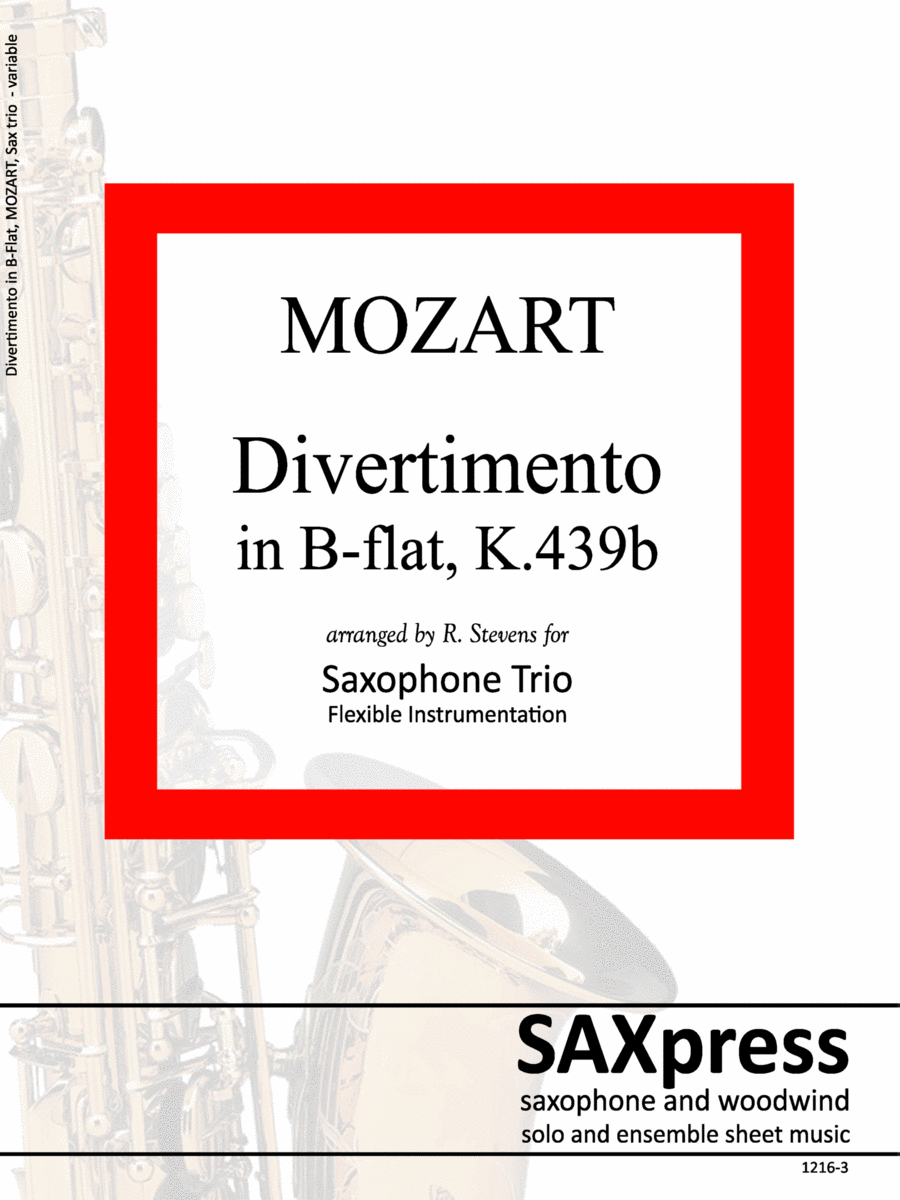Saxophone Trio,Woodwind Ensemble Alto Saxophone,Baritone Saxophone,Soprano Saxophone,Tenor Saxophone - Level 4 - Digital Download SKU: A0.1405116 Composed by Wolfgang Amadeus Mozart. Arranged by Robert Stevens. Chamber,Classical. 60 pages. SAXpress.com #988156. Published by SAXpress.com (A0.1405116). Divertimento in B Flat (1783) K439b no 2 W. A. Mozart ((1756 – 1791)) Saxophone Trio, flexible instrumentation Divertimento in B Flat K.439b by Mozart, arranged for sax trio, flexible instrumentation. This is number two of a set of five divertimentos written around 1783. Originally, the works were written for 3 basset horns but were also performed by other wind and string ensembles. They are commonly performed by two clarinets and a bassoon today. This arrangement is for saxophone trio with flexible scoring.Divertimento in B Flat has five movements: Allegro (Common time, tempo around 124 bpm, B-flat major throughout, about 2.25 minutes) Minuetto 1 (3/4 time, tempo around 124-136 bpm, ABA form, B-flat major to E-flat major to B-flat, about 3.75 minutes) Larghetto (3/4 time, tempo around 60 bpm, B flat major throughout, about 4 minutes) Minuetto 2 (3/4 time, tempo around 136 – 144 bpm, ABA form, B-flat major to F to B-flat major, about 3.5 minutes) Rondo (2/4 time, tempo around 144 – 152 bpm, ABACA form, B-flat major except when the C section wanders to F minor, about 3.25 minutes) The first movement features a lively main theme and a carefree, somewhat mellow alternate theme. Minuet 1 has a graceful main theme and relaxed, somewhat playful trio section. The movement three Larghetto is slow and dreamy. It even seems to yawn when the music several times indulges in long pauses. The second Minuet movement is livelier and a bit more colorful and playful than the first with a lively trio section. The concluding Rondo (Allegro) is energetic and colorful, with syncopations and interesting key shifts to add interest.This version of Divertimento in B-flat includes the following parts: Full trio score (C score), 20pp Part 1 – soprano saxophone, 8pp Part 2 – soprano saxophone 2, 8pp Part 2 – alto saxophone, 8pp Part 3 – tenor saxophone, 8pp Part 3 – baritone saxophone, 8pp The printed score and parts are 9″x 12″. The alternate parts included with this arrangement allow a great deal of flexibility in your ensemble. The parts can be played in any combination as long as part one, two, and three are covered. Probably Soprano-Alto-Tenor or Soprano-Alto-Baritone would be the most common grouping. However, even though it is not specified on the parts, there is no reason the piece could not be played by a Tenor/Tenor/Baritone ensemble. Also if a bass sax is available it could certainly cover the part 3 tenor sax part.
